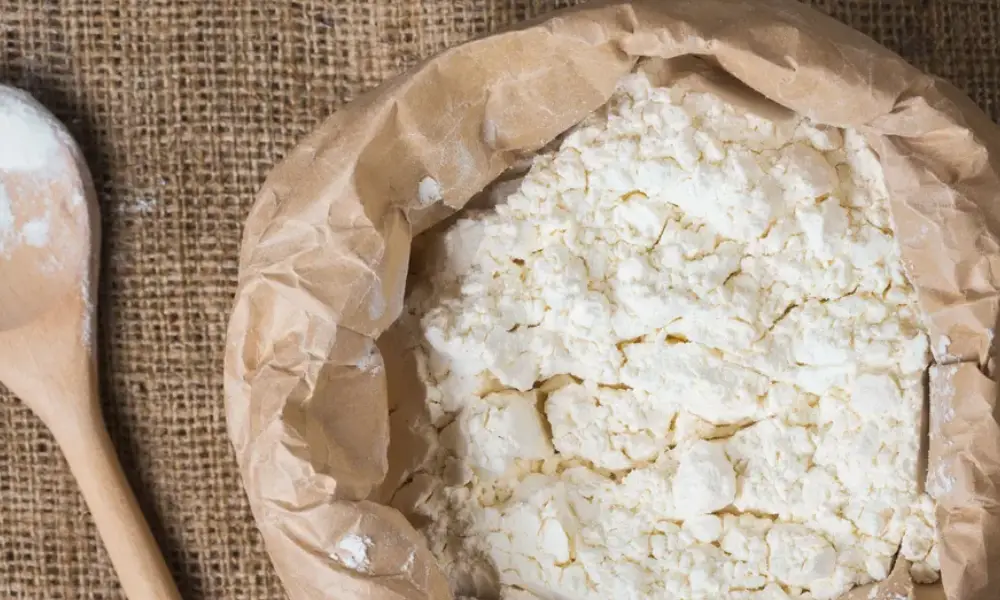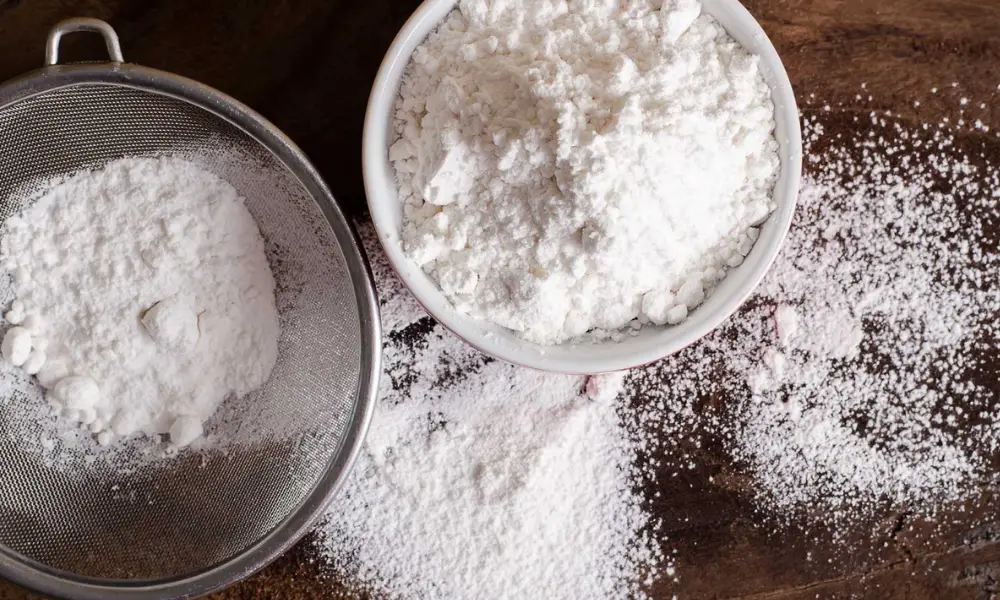You might have wondered how to keep pests out of flour storage. The type of flour you have greatly impacted the answer to this question. Flour can be kept in various containers, including Mylar bags and 3.5-gallon plastic buckets with covers. Check the expiration date, use plastic containers to keep the flour off the floor, and always store it in a dark, cold location if you want to keep it free of bugs.

Flour is one of the cupboard essentials that most people believe will always be available. Despite being considered non-perishable, flour can start to go bad when it is exposed to moisture, air, and sunshine. There are many effective ways to store flour to ensure it keeps its freshness, and I know I’m guilty of buying it in one of those three-pound bags and gradually utilizing it over a few years.
How to Store Flour?
Do you know how keeping dry ingredients in airtight food storage containers has become so fashionable? Using those containers will assist many of your items, like flour, last longer on the shelf, so your pantry will not just seem tidy and organized. It can be kept fresh for up to 10 months by storing it in airtight plastic containers or a glass Mason jar, which keeps pests like flour bugs at bay. If you vacuum seals your flour, it can keep for up to two years if you have the right equipment.
Although numerous types of flour may be purchased, remember that specialty flours (such as whole wheat flour, almond flour, and others) typically go bad sooner than all-purpose flours from well-known brands.
Store Packaging
As long as the packaging is undamaged and free of tears or holes, you shouldn’t have any issues with pantry pests if you plan to use a container of flour or grains quickly. If you intend to preserve your food for more than a few weeks, transfer it to a heavy-duty container because cardboard, paper, and plastic cannot keep insects out of it. Keep your shelves dry and clean to prevent the accumulation of crumbs, which can attract insects. Use older food packaging before using newer ones, and avoid storing new packaging adjacent to older ones since insects could spread from the older packaging to the new.
Refrigerating
Grains and flours keep nicely in the refrigerator. If despite your best efforts, you still have issues with insects, this is a good alternative. To avoid moisture loss, which could lower the flour’s quality, store flour in a container with a secure lid and seal. According to the Virginia Cooperative Extension, whole-wheat flour keeps its quality for six to eight months, whereas white flour can last up to a year in the refrigerator. For up to 18 months, corn meal can be kept in the refrigerator. Both white and brown rice keep nicely in the fridge.
Freezing
Brown rice and whole-wheat flour benefit from being kept in the freezer since doing so prevents their oils from turning rancid, which happens when they are kept for extended periods at room temperature. The freezer has a two-year shelf life for corn meal, whole-wheat flour, and white flour. In the freezer, you can keep rice for up to a year. Store your grains and flours in airtight containers or strong freezer bags to avoid moisture issues.
Refined Flours
To obtain refined flour from the endosperm of the wheat, producers remove the bran and germ. The procedure yields a pale or white tint and a fine, soft texture. All-purpose, white bread, cake, and self-rising flours are examples of refined flours. These flours are more shelf-stable than whole-grain and other kinds because they contain less oil, which makes flour spoil when it oxoxidizesPut the flour in the freezer for 48 hours after you get it home from the supermarket to get rid of any insect or weevil eggs that might be hiding in the packaging. After that, remove the flour from its retail packing and place it in a glass or plastic food-grade container with a tight-fitting cover. This keeps flies and other pests out and stops moisture from seeping in. Additionally, it prevents flavors and scents from other meals or items kept nearby from influencing the flavor or aroma of the flour.
All-purpose flour and other refined flours should be kept in the dark, cold location away from direct sunlight. Under these ideal circumstances, refined flour can be stored in the cupboard for up to a year. Put the flour in the freezer to extend its shelf life if you live in a warm environment or for longer storage. For optimal results, especially when baking, let the flour come to room temperature before using it. The cold does not dramatically influence the texture, so you can scoop out just the amount you need.
Flour on Shelf
Whole-grain flours have both the bran and the germ in addition to the endosperm, making them high in fiber and nutrients but also more prone to rotting quickly due to the oils in the bran and germ that, when they oxidize, destroy the flavor of the flour. Whole grain flours come in whole wheat, oat, rice, rye, nut (like almond flour), and seed variations.
Similar to how you would with refined flour, freeze whole-grain flour for 48 hours before transferring it to an airtight container. After that, you may keep it in the fridge for up to six months or in the freezer for up to a year. Whole-wheat and other specialty flours go rancid more quickly at room temperature because they contain more natural oils.
Bugs and Rancid Smells
Weevils are the insects that inhabit flour and other grains. If you discover them, the flour packet from the store likely carried them home. Within the grain kernel, female weevils lay their eggs, which hatch one to five months later. Any brown surface indicates eggs on top of the flour. You have bugs if you notice a minty smell after rubbing some brownish powder between your fingers. The rim of a glass can also be filled tightly with dubious flour, and a smooth surface can be created with a knife. You can assume that bugs were moving if the tight surface looked shattered. For a few hours, let the flour be in the sun. Discard the flour.
Because of oxidation caused by exposure to air and moisture, the lipids in whole grain flours produce rancid odors. Inadequate storage over time damages the freshness of your flour alters the outcome of your baking, and could even make you sick. Throw away your flour if it smells musty.
Containers
Keeping your grains and flour in glass or metal containers is the easiest way to keep pests out. Robust plastic will also work. Put your food in containers with tight-fitting lids, like ones with a screw top or a tight seal all the way around. You can transfer the original packing directly into a container if you are certain that it is bug-free. On the packaging, look for webbing or holes. Emptying your flour and grains into containers and providing a scoop for use may be simpler.
Attach a label with the type of flour and the date of purchase to the plastic or glass container you’re using to store flour. This enables you to keep track of the flour’s age and begin verifying its freshness at the right moment.
To assess the quality of the flour in your cupboard, abide by these rules:
- For up to two years, refined flours, including all-purpose, pastry, and self-rising, stay fresh. You may tell whether they are past their prime by their fragrance; ruined flour smells foul.
- Almond, flax, and hemp flours, which can stay up to a year in the freezer, store well there. A harsh or burned taste denotes deterioration.
- The shelf life of whole-grain flours like wheat, spelled, and barley is between three and six months, although they degrade much more quickly.
- Check the expiration date before using them, and store them in the refrigerator. If they have a strange odor, it would be best to discard them.
Can You Keep Flour in the Fridge?
If properly maintained, the majority of flour kinds can be kept in the refrigerator for up to a year. Utilizing an airtight container and marking it with utilizing first stored it is a fantastic idea so you can maintain track.
Additionally, it would help if you kept your flour refrigerated and away from anything that can emit moisture because moisture can degrade the quality of the flour and make it clump.
Can You Freeze Flour?
The best option for flour storage is in the freezer if you purchase it in large quantities or don’t use it frequently. If frozen flour is kept in a container with oxygen absorbers, its shelf life is unbounded. Vacuum-sealing systems and Mylar bags are the best methods for removing the most air and maintaining freshness.
Before removing the flour from the container and taking it out of the freezer, let it warm to room temperature. As a result, the flour won’t be exposed to moisture or become damp, making it clump and spoil.
Can Flour Go Bad?
Yes, terrible flour does exist. Fortunately, it’s clear when it’s time to discard your flour supply. Flour can most easily be spoilt and detected by scent. Throw away your flour if it smells stale, rancid, or musty. Suppose your flour develops moldy lumps or changes color. It’s time to purchase a new bag if that’s the case.
Why are Flour Bugs a Problem?
Although annoying, flour bugs are rarely a significant issue. They are tiny, don’t bite, and, if discovered quickly, are often contained in a single container of flour. But if left uncontrolled, they can infect an entire pantry, wasting a significant amount of food and money. They can also eat through paper, plastic, and cardboard. Or, as happened to me, they can infest an entire apartment, leaving you to spend the night with a spray bottle of cleaning solution beside your bed.
Can Flour be Vacuum-Sealed for Long-Term Storage?
For instance, whereas flour and sugar may last up to six months in the cupboard, they can last up to two years when vacuum-sealed. The same findings may apply to rice and pasta; both foods may last up to six months when kept traditionally but one to two years when vacuum packed.
How do You Store Flour Longer without Bugs?
The flour is protected from light, moisture, and oxygen by sealing it in Mylar bags with oxygen absorbers. Because the packing lacks oxygen, even insect eggs cannot hatch. In this manner, whole-wheat flour can be stored for roughly ten years. White flour can be kept in this manner for 10 to 15 years.
Is it Better to Store Flour in Glass Or Plastic?
Transferring your flour to an airtight plastic or glass container is the simplest way to keep it fresh and bugs out. Chef Sarah House of Bob’s Red Mill says, “Bugs love food, especially nutritious whole grain foods, and if they can find a way in, they’re going for it!”
Conclusion
The pantry essential of flour is susceptible to rancidity and vermin, neither of which will improve the taste of your bread unless you consume it very quickly. Therefore, appropriate flour storage is crucial. And all you have to keep in mind are the three rules for storing flour.
Because whole-wheat or whole-grain flours include more naturally occurring oils that can expire, they should be thrown away after one month at room temperature, three months at a colder indoor temperature, six months in the refrigerator, or a year in the freezer.

